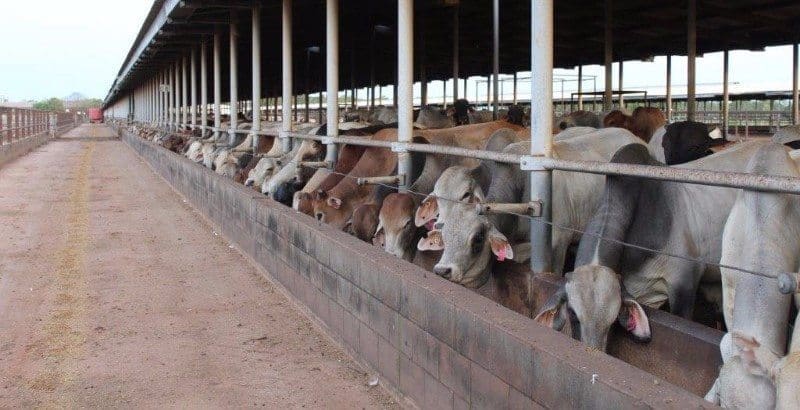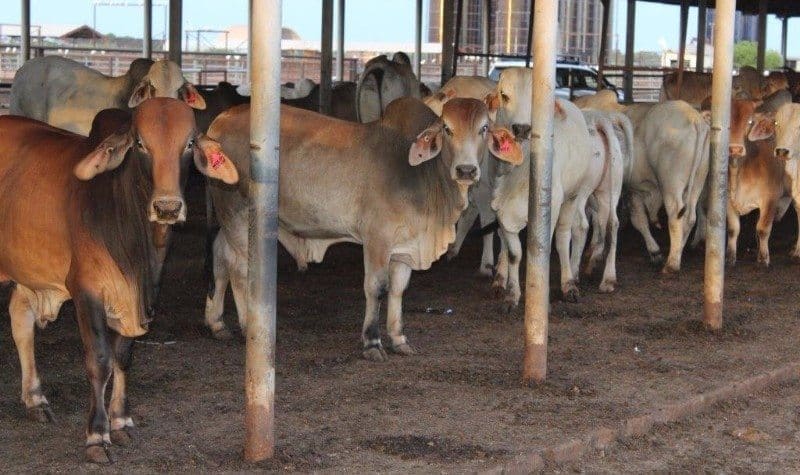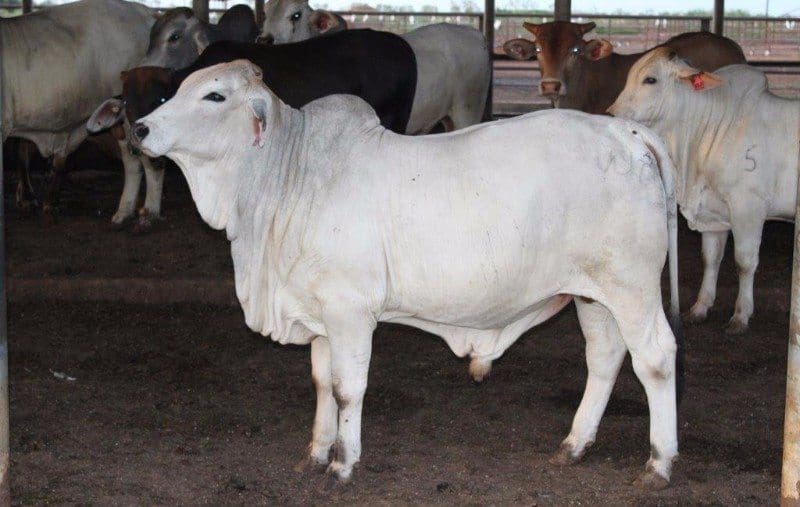
Part of a line of 380 young bulls from a production feeding trial near Katherine, sold to live exporters on Friday for 368c/kg liveweight.
WILL Northern Australia’s opportunity feedlots start to fill up as a result of Indonesia’s decision last week to increase allowable cattle weights?
Greater use of pre-export feeding of cattle is a prospect already being discussed in the wake of Indonesia’s decision last week to lift livestock weight limits to 450kg (maximum average weight, per consignment).
If the practise of consigning cattle well above the former 350kg average weight limit becomes popular, production feeding of live export cattle to add additional weight before sale to live exporters could become more commonplace.
In North Queensland, there are a number of feedyards that are used on an opportunistic basis for live export operations, but which may come back into play as Indonesia again starts to import heavier cattle, after a seven year weight limit.
Whether owners start feeding cattle to add weight before sale to the Indonesian market would depend on the sums, Townsville stock agent Tim McHugh said yesterday.
“During the 2015-16 drought years, quite a lot of yard feeding of young cattle took place to get them to minimum live export weights, and its possible it might re-emerge now that Indonesia is about to accept heavier cattle,” he said.
“Whether there is now an incentive to feed for Indonesia, to exploit the higher upper weight limit will depend on a few factors,” Mr McHugh said.
“Cost will be the big issue, together with seasons. It’s going to come down to a breakeven analysis. If the cost of adding the weight in the yard is cheaper than the live exporters’ purchase price of the live steer, then it’s likely to look attractive. That’s going to be influenced, obviously, by the cost of feed, and the market price for cattle at the time of delivery,” he said.
“People will no doubt do some sums, to determine whether it is now worthwhile putting cattle on feed before sale to Indonesia at heavier weights.”
Several large North Queensland yards have fed for live export purposes over the past two or three years.
Peter Hammer operates a feedlot on the Burdekin River near Charters Towers, which since 2014 has fed large numbers of cattle for Elders and other clients for live export. Much of that involved light weaners 180-200kg, taking then through to 270-300kg in order to qualify for Indonesian orders.
Dingo Park feedlot (previously known as Longyard), south of Townsville is another example. The facility has a license for 30,000 head, and is currently constructed for 10,000 head capacity. The yard is being developed by Burdekin sugar producer David Cox – one of Australia’s largest cane growers.
Peter Hall’s Laurel Hills feedlot between Clermont and Charters Towers, and Lotus Park, south of Nebo, have also fed cattle for both live export and slaughter in the past three years.
Katherine live export feedlot trial shows promise
Just this week, an encouraging feeding trial designed to add weight to live export cattle is winding-up in a feedlot and depot facility near Katherine, in the Northern Territory.
The Phoenix Park depot facility, owned by Gina Rinehart’s Hancock Prospecting, has been the site of a trail. Proprietors Brett and Jodie Wild and George Hurst lease the feedlot and Katherine Cattle Yards facility off Hancock Prospecting.

Young Brahman bulls involved in the Katherine feeding trial
The facility is normally used for short-term depot feeding of boat cattle using hay, but the Wilds saw an opportunity to trial some extended production feeding on a higher energy ration.
The couple bought 380 young bulls from Hancock Prospecting for the trial, feeding them on a ration comprising 50pc corn sourced out of Kununurra, 40pc locally-grown sorghum silage, dolomite plus some molasses-based liquid supplement carrying a double ionophore supplied by Ultralix at Charters Towers.
The bulls were drafted into two lines on weight, averaging 235kg and 276kg at induction. They have now been on feed for 90 days, and have produced an average daily gain over the past 30 days of 1.51kg, and better than 1.3kg across the whole trial period. The cattle came in at the back-end of the dry season in November, and boosted by compensatory gain, have delivered a cost of gain $3.17-$3.30/kg (Editor’s note: This figure has been amended since original publication, due to a calculation error concerning dry matter being adjusted twice). That looked attractive, against a current live export steer purchase price ex Darwin of $3.65-$3.75c/kg. Ages ranged from 18-30 months.
Wet season conditions have not helped, and the Wilds are keen to repeat the trial during the northern dry season. The better end of the bulls are tipped the scales at 440kg liveweight at close-out – well above the old Indonesian weight limit of 350kg, and suitable also for Vietnam. The cattle have additional attractions to Indonesian buyers being quiet and well-adjusted to bunk feeding.
“Production feeding like this is only likely to grow, now that Indonesia is talking about boat cattle averaging as much as 450kg,” trial coordinator Brad Monk from Ultralix in Charters Towers said.
“I call it opportunity feeding, rather than lotfeeding,” Mr Monk said. “It’s not about feeding cattle for finish, it’s about feeding for weightgain. It’s a matter of balancing the diet so the cattle are growing muscle, not fat, and utilising that compensatory gain in cattle at the end of the dry season.”
Mr Monk said the Phoenix Park facility was licensed for 10,000 head during the wet season and 20,000 head during the dry, meaning larger numbers could be fed if the opportunity arose.
“I’ve never seen so much demand for people trying to put weight onto cattle in the north,” Mr Monk said. “Obviously the short supply of cattle means everybody is trying to maximise what they are doing, with the stock they have,” he said.
The Phoenix Park trial bulls were sold in one line on AuctionsPlus on Friday, making 368.5c/kg, or $1241/head, bought by a Darwin live exporter.

Example of the of the feeding trial young bulls that gained at better than 1.5kg/day during the back half of the Katherine feeding trial. The best of the bulls were above 400kg liveweight at sale on Friday.



We can do better than that in a paddock situation if you have plenty of dry feed and it works out way cheaper if any one is interested .
lets see who can put weight on them cheaper.. the Indonesians or the australians?
Indonesians will buy the cattle that offers them the best margins in their business. Best margins are still with good feeder cattle. ready to slaughter cattle (450 kgs) will have to be cheaper. example ( the bulls in the photo have $1.20 more cost to put on the buy price to arrive in Indonesian feedlot) thats put its at $4.88 (add 5% plus before taxes … thats going to be IDR 53,000/kg. Current sale price is 42,000 Jakarta. Old mate that paid that money, wont be shouting too much at Xmas time..
you cant have your cake and eat it too.. by all means fatten the cattle but you will need to drop the price.